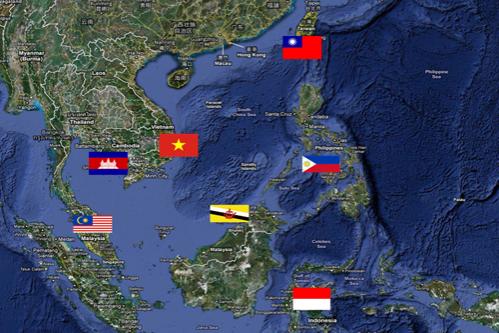
U.S. & CHINA WARSHIPS

The US is poised to sail warships close to China's artificial islands in the South China Sea as a signal to Beijing that Washington does not recognise Chinese territorial claims over the area.
A senior US official told the Financial Times that the ships would sail inside the 12-nautical mile zones that China claims as territory around some of the islands it has constructed in the Spratly chain. The official, who did not want to be named, said the manoeuvres were expected to start in the next two weeks.
The move, which is likely to raise tensions between the powers, comes amid disagreement over several issues, including US allegations that China is engaging in commercial cyber espionage.
China's assertiveness in the South China Sea has grown in recent years, with its navy engaging in activities that the US says threatens freedom of navigation in an area through which 30 per cent of global trade passes. Over the past two years it has stepped up its maritime activities, reclaiming thousands of acres of land for airstrips and other military installations aimed at enhancing its power projection in the Pacific.
Military experts say the island building is aimed at furthering China's goal of building a "blue-water navy" that can operate far from shore, particularly beyond the so-called "first island chain" that encloses the South China, East China and Yellow Seas, and separates them from the Pacific.
Chinese warships have also been operating in waters close to the US. Last month five vessels sailed off the coast of Alaska while Mr Obama was making a visit to the arctic region — the closest the Chinese navy had come to the US mainland without an invitation.
Ashton Carter, US defence secretary, has been seeking permission to take more assertive maritime actions for months. The White House had resisted because of concerns that such actions would escalate the situation in the contested waters of the South China Sea. But it finally agreed after officials failed to make headway on the issue during Chinese President Xi Jinping's recent visit to Washington.
In his press conference with Mr Xi last month, President Barack Obama said he had expressed "significant concerns over land reclamation, construction and the militarisation of disputed areas", and stressed that the US would "continue to sail, fly and operate anywhere that international law allows".
Paul Haenle, a former China adviser to Mr Obama and George W Bush who heads the Carnegie-Tsinghua Center in Beijing, said that while the US navy operations might create some friction in the short term, it would be in the US long-term interests.
"For the US to effectively advance and protect its interests in the Asia-Pacific, including upholding regional and global rules and norms, it may require our relationship to tolerate some friction and greater competition in the short term," said Mr Haenle. "In the long term, a strong approach can help encourage constructive behaviour and ensure the security and prosperity of the region."
While the US has routinely sailed ships through international waters in the South China Sea, it has refrained from sending them inside the 12-nautical mile zone of the artificial features since 2012, which was before China ramped up its construction activities around the Spratlys.
The new tack is intended to reinforce the US stance that China's claims are not consistent with international law, including the United Nations Law of the Sea (Unclos).
Speaking in Australia this week, Admiral Scott Swift, commander of the US Pacific Fleet, criticised China indirectly by saying "some nations view freedom of the seas as up for grabs" and as something that could be "redefined by domestic law or by reinterpreting international law".
"Some nations in this region continue to impose superfluous warnings and restrictions on freedom of the seas in their exclusive economic zones and claim territorial water rights that are inconsistent with Unclos," said Adm Swift. "This trend is particularly egregious in contested waters."
The White House declined to comment on "potential freedom of navigation operations in the South China Sea", saying such operations were "classified".
Rory Medcalf, an Asia expert at Australian National University, said there were "no easy or risk-free options for challenging China's passive-aggressive strategy of manufacturing and militarising islands" in the region. "If the US is serious about ensuring that China does not dominate these waters, then the longer it waits, the riskier its freedom-of-navigation activities will become."
The plan for US naval manoeuvres comes as an international tribunal at The Hague prepares to rule whether it has jurisdiction to hear a case that the Philippines brought against China. Manila wants the court to invalidate the "nine-dash line" — a demarcation on Chinese maps that implies Chinese sovereignty over most of the South China Sea's resource-rich waters.
Antonio Carpio, a Philippines Supreme Court justice who is one of the most outspoken critics of China's actions in the South China Sea, said that if the court determined it did not have jurisdiction, the nine-dash line would stand and China would use the victory to justify expanded efforts to assert sovereignty in the region.
Justice Carpio said a loss for the Philippines would force Manila to divert money from education to build a more credible military deterrent. He also cast blame on the US for not supporting Manila's claim that some features in the South China Sea — particularly Scarborough Shoal, which he said the US had historically considered part of the Philippines — were its territory.
China wrested control of Scarborough Shoal, a reef 200km from Subic Bay, off the Philippines in 2012 following a tense two-month naval stand-off.
The state department said the longstanding US policy on the South China Sea was that the US "don't take a position on the competing sovereignty claims to land features in the South China Sea".
ft.com
-----
More:






